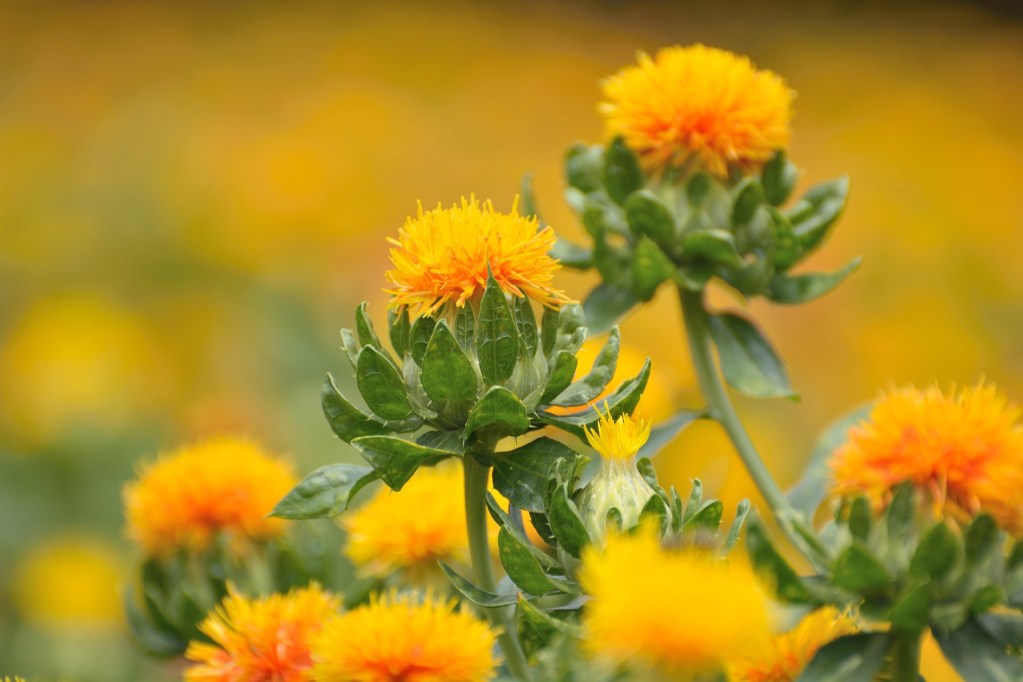Lifestyle
Discover Why Cold-Hardy Safflower is a Garden Essential

Garden enthusiasts are increasingly turning to the cold-hardy safflower, known scientifically as Carthamus tinctorius, as an appealing addition to their outdoor spaces. This versatile plant, part of the daisy family, thrives in cooler climates and is notable for its vibrant flower clusters that transition from yellow to orange to red.
Understanding Safflower’s Appeal
Safflower can grow up to three feet tall and features thistle-like silvery foliage. Each flower cluster comprises multiple florets that produce achenes, which are small dry fruits containing seeds. These seeds are harvested for safflower oil, making the plant not only visually appealing but also economically beneficial. The approximately 180 tightly packed florets contribute to its attractiveness in gardens, while its long stems make it suitable for dry flower arrangements.
In addition to safflower, Southern California gardeners will find October to be an optimal month for planting a variety of vegetables. This time of year is particularly favorable for crops such as lettuce, radishes, carrots, and onions, which thrive in the cooler temperatures.
Herbs and Flowers That Flourish
Among the herbs, yarrow, or Achillea spp., stands out for its medicinal properties. This hardy plant is celebrated for its ability to grow in extremely cold regions and is often used in traditional remedies. Its effectiveness in treating ailments such as headaches and flu is well-documented, with its name deriving from the Greek hero Achilles, who purportedly utilized it for wound care.
Similarly, coneflower, or Echinacea, is recognized for both its beauty and health benefits. With vibrant pincushion flowers in shades of pink, white, and purple, coneflowers attract pollinators such as birds, bees, and butterflies. They are resilient in colder climates and can flourish in various soil types, although they prefer fast-draining sandy loam.
For those who appreciate silver-leaved plants, the daisy family offers several options, including wormwood (Artemisia absinthium) and dusty millers. While these plants may have less prominent flowers, their silvery foliage adds a distinct charm to any garden. Centaurea gymnocarpa is a notable species, growing to a height of three feet with striking purple inflorescences.
As gardeners prepare for the upcoming season, embracing cold-hardy plants like safflower and exploring the benefits of various herbs and flowers can enhance both the aesthetic and functional value of their gardens.
-

 Lifestyle3 months ago
Lifestyle3 months agoLibraries Challenge Rising E-Book Costs Amid Growing Demand
-

 Sports3 months ago
Sports3 months agoTyreek Hill Responds to Tua Tagovailoa’s Comments on Team Dynamics
-

 Sports3 months ago
Sports3 months agoLiverpool Secures Agreement to Sign Young Striker Will Wright
-

 Lifestyle3 months ago
Lifestyle3 months agoSave Your Split Tomatoes: Expert Tips for Gardeners
-

 Lifestyle3 months ago
Lifestyle3 months agoPrincess Beatrice’s Daughter Athena Joins Siblings at London Parade
-

 World3 months ago
World3 months agoWinter Storms Lash New South Wales with Snow, Flood Risks
-

 Science3 months ago
Science3 months agoTrump Administration Moves to Repeal Key Climate Regulation
-

 Business3 months ago
Business3 months agoSoFi Technologies Shares Slip 2% Following Insider Stock Sale
-

 Science3 months ago
Science3 months agoNew Tool Reveals Link Between Horse Coat Condition and Parasites
-

 Science2 months ago
Science2 months agoSan Francisco Hosts Unique Contest to Identify “Performative Males”
-

 Sports3 months ago
Sports3 months agoElon Musk Sculpture Travels From Utah to Yosemite National Park
-

 Science3 months ago
Science3 months agoNew Study Confirms Humans Transported Stonehenge Bluestones









